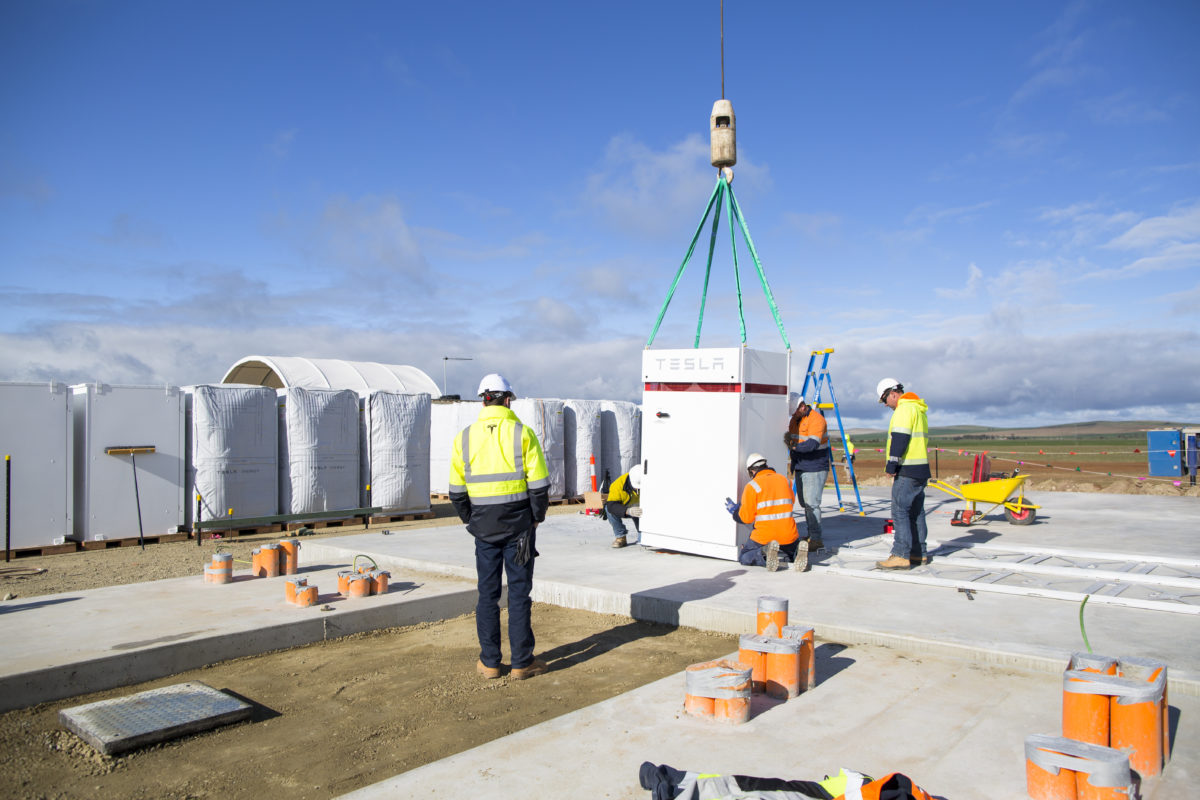It wasn’t a well-kept secret, but it’s hard to keep very big battery projects under wraps. The 50% expansion of the Hornsdale Power Reserve is set to make history as the first battery to provide grid-scale inertia services and fast-frequency response on Australia’s National Electricity Network.
The project, located in Jamestown in South Australia and adjacent to the 315 MW Hornsdale Wind Farm, has already demonstrated the value of large-scale battery storage in a number of ways. It has brought down grid stabilization costs, by some $40 million according to consultants Aurecon in its first year of operation alone.
At the same time, Hornsdale generated roughly $50 million in revenues in less than two years through the provision of both Contingency and Regulation Frequency Control Ancillary Services (C/FCAS) and through arbitrage trading – buying electricity when wholesale prices are low or even negative and selling when prices are high. Even during severe grid anomalies, such as those impacting an interstate interconnector after a lightning strike, the big battery has successfully kept the lights on in South Australia’s renewable-heavy grid.
“The expansion of Hornsdale Power Reserve is demonstrating the critical and multiple roles that batteries will play in the grid of the future,” said Louis de Sambucy, Neoen Australia MD in a statement.
The expansion of the project is also a windfall for Tesla, with revenues from its stationary storage activities set to see a Q4 2019 boost. Today’s confirmation of the project’s expansion disproves claims from many sceptical of Tesla’s technology who had forcefully argued, directly to pv magazine Australia’s inboxes, that the reports of battery packs on their way to the Hornsdale site were evidence that many of the installed battery units were in need of early replacement.
Just add inertia
Expanding the services provided by Hornsdale is likely to open up more opportunities of utility scale storage in Australia. Having already provided “proof-of-concept” in FCAS provision, Hornsdale will be tasked with supplying fast-frequency response and system inertia – termed synthetic or digital inertia when delivered by battery storage. Previously, large fossil-fuel or hydro-electric units, or synchronous generators, have provided system inertia by virtue of their spinning turbines, sometimes described as a large-rotating mass.
The Australian Renewable Energy Agency (ARENA), having tipped in a $8 million grant towards the project, says that Neoen will report to the Australian Electricity Market Operator (AEMO) to provide operational data relating to the provision of grid inertia, potentially allowing grid rules to be redrawn. A successful result could see changes to AEMO’s Market Ancillary Services Specifications, opening the way for storage to participate in grid regulation markets in new ways. ARENA says that it could also reduce solar PV and wind curtailment in South Australia.
“Large-scale batteries are playing an important role in providing short term, large-scale energy storage to help firm and balance the grid,” said ARENA CEO Darren Miller in a statement. “The Hornsdale battery is a ground-breaking project that has proven what batteries can do for our electricity system, and this expansion will now show that it is capable of much more by demonstrating inertia, expanded FCAS functionality and extended support for the Heywood interconnector.”
ARENA reports that increased power flows along Heywood could be an additional benefit of an expanded Hornsdale Power Reserve. As the primary interconnector between South Australia and Victoria, increased power flows may push down electricity spot prices, according to ARENA.
Along with ARENA, both the CEFC and the South Australian State Government are supporting the Hornsdale expansion. South Australia is tipping in $3 million a year over five years from its Grid Scale Storage Fund, which was established in November 2018. The CEFC is providing $50 million in debt finance and given the very healthy revenues achieved by Hornsdale’s first stage, it appears a good bet.
CEFC CEO Ian Learmouth said that the provision of synthetic or digital inertia is “critical” if renewable penetration levels are to continue to grow: “The Hornsdale Power Reserve has already delivered substantial benefits to South Australia, providing grid reliability, reducing energy costs and integrating the state’s substantial renewable energy resources into the grid. It is an exciting model that can be extended across the grid to improve security.”
The Hornsdale Power Reserve is clearly an Australian energy-transition project of national and even global significance. Federal Energy Minister Angus Taylor issued a statement noting that the “influx” of renewable energy and thermal power retirement was requiring the implementation of “new measures… to support reliability”.
Neoen hosted a media and stakeholder event at the Hornsdale site today. It was attended by the South Australian Minister for Mining and Energy Dan van Holst Pellekaan, Neoen’s Louis de Sambucy, and ARENA CFO Ian Kay. Local federal MP Rowan Ramsey attended on behalf of Angus Taylor.
This content is protected by copyright and may not be reused. If you want to cooperate with us and would like to reuse some of our content, please contact: editors@pv-magazine.com.









In your statements you do not include wave energy and always available especially on the islands.